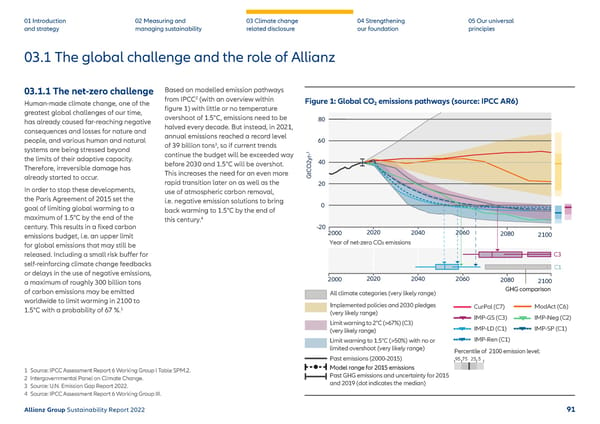01 Introduction and strategy 02 Measuring and managing sustainability 03 Climate change related disclosure 04 Strengthening our foundation 05 Our universal principles 03.1 The global challenge and the role of Allianz 03.1.1 The net-zero challenge Human-made climate change, one of the greatest global challenges of our time, has already caused far-reaching negative consequences and losses for nature and people, and various human and natural systems are being stressed beyond the limits of their adaptive capacity. Therefore, irreversible damage has already started to occur. In order to stop these developments, the Paris Agreement of 2015 set the goal of limiting global warming to a maximum of 1.5°C by the end of the century. This results in a fixed carbon emissions budget, i.e. an upper limit for global emissions that may still be released. Including a small risk buffer for self-reinforcing climate change feedbacks or delays in the use of negative emissions, a maximum of roughly 300 billion tons of carbon emissions may be emitted worldwide to limit warming in 2100 to 1.5°C with a probability of 67 %. 1 Based on modelled emission pathways from IPCC 2 (with an overview within figure 1) with little or no temperature overshoot of 1.5°C, emissions need to be halved every decade. But instead, in 2021, annual emissions reached a record level of 39 billion tons 3 , so if current trends continue the budget will be exceeded way before 2030 and 1.5°C will be overshot. This increases the need for an even more rapid transition later on as well as the use of atmospheric carbon removal, i.e. negative emission solutions to bring back warming to 1.5°C by the end of this century. 4 Figure 1: Global CO 2 emissions pathways (source: IPCC AR6) 1 Source: IPCC Assessment Report 6 Working Group I Table SPM.2. 2 Intergovernmental Panel on Climate Change. 3 Source: U.N. Emission Gap Report 2022. 4 Source: IPCC Assessment Report 6 Working Group III. -20 0 20 40 60 80 GtCO2yr- 1 Year of net-zero CO2 emissions GHG comparison C3 C1 All climate categories (very likely range) Implemented policies and 2030 pledges (very likely range) Limit warning to 2°C (>67%) (C3) (very likely range) Limit warning to 1.5°C (>50%) with no or limited overshoot (very likely range) CurPol (C7) ModAct (C6) IMP-GS (C3) IMP-Neg (C2) Past emissions (2000-2015) Percentile of 2100 emission level: 95 75 25 5 Past GHG emissions and uncertainty for 2015 and 2019 (dot indicates the median) Model range for 2015 emissions 2000 2100 2020 2040 2060 2080 2000 2100 2020 2040 2060 2080 IMP-LD (C1) IMP-Ren (C1) IMP-SP (C1) Allianz Group Sustainability Report 2022 91
 Sustainability Report 2022 | Allianz Page 91 Page 93
Sustainability Report 2022 | Allianz Page 91 Page 93